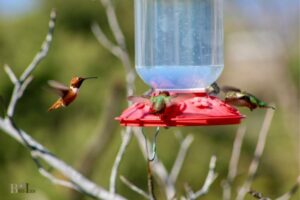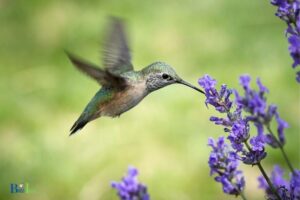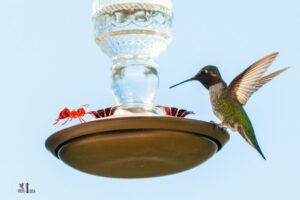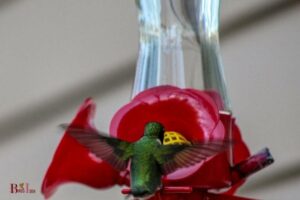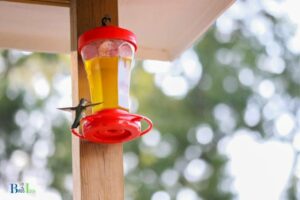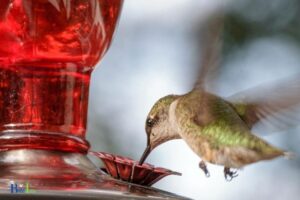How to Make a Window Hummingbird Feeder: Assembling!
Making a window hummingbird feeder involves gathering the necessary materials, assembling the feeder, filling it with nectar, and mounting it securely to your window for easy viewing and enjoyment of hummingbirds.
A window hummingbird feeder allows you to enjoy these fascinating creatures up close while providing them with a vital source of food, especially during long migrations.
The process of making one involves a few simple steps, materials, and considerations, ensuring the safety and comfort of the visiting birds.
Fill the container with the homemade nectar solution and mount your feeder securely to the window. Make sure to regularly clean and refill the feeder to ensure the health and continued visits of your new feathered friends.
6 Steps to Make a Window Hummingbird Feeder:
| Step | Description | Materials Required |
| 1 | Choose a feeder type | Window hummingbird feeder with suction cups |
| 2 | Prepare the nectar | Sugar, water (4:1 ratio), pan, stirring spoon |
| 3 | Clean the feeder | Warm water, mild soap, small brush |
| 4 | Fill the feeder | Funnel, nectar |
| 5 | Attach the feeder to the window | Suction cups, damp cloth |
| 6 | Monitor and maintain | Refill as needed, clean every 3-4 days |
Key Takeaway
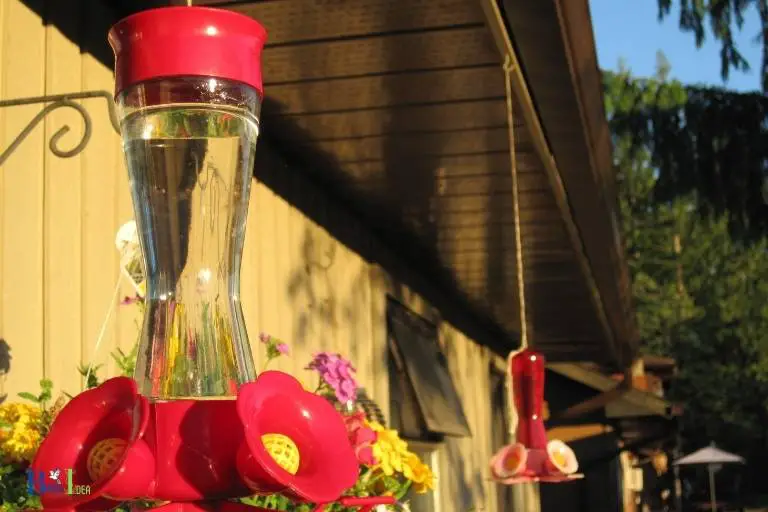
Five Facts About: Make a Window Hummingbird Feeder
Step 1: Designing Your Feeder
Window hummingbird feeders are a great way to attract these amazing little birds to your home. Designing your own feeder can be a fun and rewarding project.
In this section, we’ll cover the factors to consider, tips for creating a visually appealing and functional design, and choosing the right materials for your feeder.
Factors To Consider When Designing Your Window Hummingbird Feeder
When designing your window hummingbird feeder, there are several important factors to keep in mind to ensure that it is safe and effective for the birds.
Here are some of the key considerations:
- Location: Choose a spot for your feeder that is easily visible from your window, but also protected from wind, rain, and predators.
- Size: Your feeder should be the appropriate size for the number of birds you expect to attract. A small feeder may be more appropriate for a few birds, while a larger feeder may be needed for a larger flock.
- Capacity: Consider the capacity of your feeder. Hummingbirds need to eat frequently, so you’ll want to make sure your feeder can hold enough nectar to feed them throughout the day.
Tips For Creating A Visually Appealing And Functional Design
A good window hummingbird feeder design not only attracts birds but is also visually appealing.
Here are some tips to help you create a feeder that is both attractive and functional:
- Choose a unique design that sets your feeder apart from the rest. Hummingbirds are attracted to bright colors and flowery shapes, so consider incorporating these elements into your design.
- Use high-quality materials that are durable and easy to clean. Glass, plastic, and metal are all good choices.
- Make sure your feeder is easy to refill and clean. You’ll want to be able to clean it thoroughly to avoid the growth of dangerous bacteria.
- Incorporate decorative elements that are both functional and attractive. For example, consider adding hummingbird figurines to the feeder to create a more inviting environment for the birds.
Choosing The Right Materials For Your Feeder
Choosing the right materials for your window hummingbird feeder is critical to its success.
Here are some of the most important things to keep in mind:
- Durability: Your feeder needs to be made from durable materials that can withstand the elements and last for several seasons.
- Cleanliness: Choose materials that are easy to clean and won’t harbor bacteria or fungus that could be harmful to the birds..
By following these tips and guidelines, you can design and create your very own window hummingbird feeder that is both beautiful and functional.
With a little bit of effort and creativity, you’ll be able to attract these beautiful birds to your home and enjoy their company all season long.
Step 2: Assembling Your Feeder
Detailed Instructions For Assembling Your Window Hummingbird Feeder
Assembling your window hummingbird feeder can be a fun and simple project with the right tools and instructions.
Here is a step-by-step guide to help you build your hummingbird feeder with ease:
- Start by cleaning all the parts of the feeder with soap and warm water.
- Take the base of the feeder and place the reservoir on top, making sure the openings line up.
- Push the stopper through the hole in the reservoir and base until it’s securely in place.
Once you have assembled all the parts, fill the reservoir with hummingbird nectar and hang the feeder outside your window. You’ll be able to sit back and watch these beautiful birds in action!
The Essential Tools You’Ll Need For Proper Assembly
To ensure proper assembly of your window hummingbird feeder, you’ll need to have a few essential tools on hand.
These include:
- Soap and warm water to clean all the parts before assembly.
- A phillips head screwdriver to attach the feeding ports to the base.
- Hummingbird nectar to fill the reservoir with once the feeder is assembled.
- A hanging bracket or suction cups to attach the feeder to your window.
With these tools, you’ll be able to assemble your hummingbird feeder with ease and ensure it’s properly installed for optimal bird watching.
Step 3: Installing And Maintaining Your Feeder
Tips For Safely And Securely Installing Your Window Hummingbird Feeder
When it comes to installing a window hummingbird feeder, it’s important to remember these safety tips:
- Ensure the suction cups or hooks you will use to hang the feeder are properly secured to the window.
- Place the feeder low on the window to avoid it falling from a great height in the event it detaches from the suction cups or hooks.
- Ensure the feeder is not blocking your view through the window.
- Use a sturdy and durable feeder with tight sealing lids to prevent accidental leaks and spills.
Advice For Choosing The Ideal Location For Optimal Hummingbird Activity
Once you have installed your window hummingbird feeder safely, it’s time to choose the ideal spot that will attract hummingbirds.
Here are some tips to help you select the right location:
- Avoid placing it in direct sunlight to prevent the nectar from spoiling quickly and to avoid overheating the birds.
- Find a place that’s protected from strong winds and rain.
- Place it near flowers or plants that attract hummingbirds to create a natural feeding spot.
- Ensure the feeder is far enough from any nearby windows or doors to prevent birds from flying into them.
Maintenance Tips For Keeping Your Feeder Clean And Well-Stocked
To help maintain hummingbird activity around your feeder, it’s crucial to keep it clean and well-stocked with fresh nectar.
Here are some tips to consider:
- Wash the feeder thoroughly at least once a week with warm soapy water and rinse with clean water.
- Refill with fresh nectar every 2-3 days, especially during hot weather, to prevent it from spoiling.
- Avoid using red dye or food coloring in the nectar, as it can be harmful to birds.
- Regularly inspect the feeder for any signs of damage or cracks and replace parts as needed.
By following these tips for safe installation, ideal location selection and regular maintenance, you can enjoy watching these magnificent birds up close with a window hummingbird feeder.
FAQ For How To Make A Window Hummingbird Feeder
How Do I Fill A Window Hummingbird Feeder?
How Do I Prevent Ants From Invading My Hummingbird Feeder?
Where Should I Hang My Window Hummingbird Feeder?
How Do I Keep My Window Hummingbird Feeder Clean?
Conclusion
By implementing the above mentioned steps, you can easily make a window hummingbird feeder at home. The most important aspect is to ensure that the feeder is safe, durable, and provides adequate nutrition for the little fluttering birds.
It is essential to keep the feeder clean and refill it frequently to attract the hummingbirds.
A window hummingbird feeder not only adds beauty to your home but also serves as a great way to attract these beautiful birds to your windowpane.
With a little bit of patience and perseverance, you can make a successful hummingbird feeder that will provide hours of entertainment for you and your family.
So, let’s start creating your very own hummingbird feeder and bring these beautiful creatures into your backyard today!

